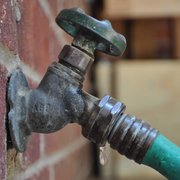People who jump into organic gardening without any preparation often start off on the wrong foot by overwatering or not watering properly. They may have stereotypes in their minds that are hard to erase. One is the image of lawn sprinklers casting long arcs of water into the air, as is often seen in photos of golf courses.
While watering with a sprinkler like that can work, it's not the best way and, if done in the heat of the day or in the evening is an example of how not to water your garden and can even be self-defeating. While it may give the gardener the impression that he or she has "done some work in the garden," it can be harmful for two reasons: First, during a hot, sunny day, the water mostly evaporates before it can soak in to the plants' roots where it can actually do some good. Second, sprinkling raises humidity in the garden, which can create ideal conditions for harmful fungal and bacterial growth, and rejuvenate viruses in the soil that can stunt or kill plants. The effect is worse if you use sprinkling techniques in the late evening; it allows fungi and bacteria to grow overnight and really "set in."
If you use a sprinkler in your garden, it's best to use it in the morning and leave it running long enough so that the water soaks in. The garden will then have all day in the sun. Water on the leaves, plant stems and the ground surface will dry out as the day goes on, leaving the water where it belongs, at the roots.
You will find that morning watering in this way can be a great delight. Birds use the puddles to splash in and wash themselves, pollinators will flitter in and out, drinking the precious liquid, and your plants will seem to grow and blossom before your very eyes as they absorb the moisture and turn their leafy faces toward the sun. It can be a spiritual experience.
The key is to not overwater. Once a week is plenty, and you may need to water less. To test whether your garden needs watering, stick your finger in the soil. If your finger goes in easily with a slight feeling of moisture, it's fine. If it's muddy, it's too wet.
It's a careful balance. Plant roots need to be able to breathe in the soil. That requires air pockets as well as moisture. You want your soil to be light and fluffy (have good "tilth") with lots of organic matter, but damp enough so that earthworms can happy slither through, and beneficial bacteria and fungi can thrive. In organic gardening, your soil is alive. It needs to thrive for your plants to thrive.
Professional gardeners, of course, have found more efficient (and often expensive) ways to water their crops. Some use garden or lawn sprinklers on tripods with timers so that they can soak a large area in a small amount of time. By moving the tripods, they're able to cover several acres. If your garden is the small, backyard variety, timers and tripods probably aren't necessary.
Drip and soaker systems are additional watering options for larger gardens. Drip irrigation sends an even supply of water directly to the root zone. It uses less water because it doesn't run off on the surface (carrying precious top soil with it) or evaporate as readily as water mist sprayed into the air. It almost eradicates mold or fungal concerns because the drip tape or soaker hose is in contact with the soil. In established crop systems, gardeners often will bury the hoses so they stay put, about 4 inches deep, so they water only the roots. Burying your soaker hoses to keep them from freezing and splitting is a good idea if you plan to leave them out during the winter.
Unburied hoses will give you the advantage of using them where they're needed most and removing them otherwise. But whether you bury your soakers or leave them above ground, you'll need to be careful when you mow around the garden, or till within it. With buried hoses, be sure to remember (or mark) where you buried them!
Soaker hoses are available at most garden supply stores and online. Because you want the water pressure to be low throughout your garden, keep your hose sections to no longer than 100 feet. If you need additional length, connect 100-foot sections using garden hose splitters with adjustable valves. That way, you can adjust the flow in each section—open the valves for highest flow at the end, lowest at the beginning.



Comments
Use the comment form below to begin a discussion about this content.
comments powered by Disqus